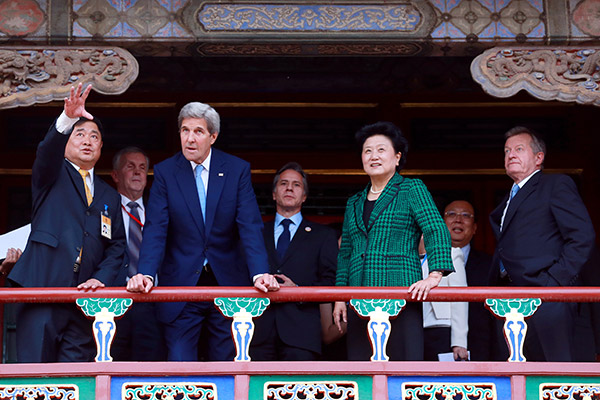
Shan Jixiang (left), curator of Palace Museum, shows Vice-Premier Liu Yandong (second from right, front row), United States Secretary of State John Kerry (second from left) and US Ambassador to China Max Baucus (right) around the facility in Beijing on June 5.[Photo by Zou Hong/China Daily]
Vice-Premier Liu Yandong and US Secretary of State John Kerry visited on June 5 a famous garden in the Forbidden City that, following extensive renovation by specialists from China and the United States, has become a symbol of the two countries’ cooperation.
The Qianlong Garden is being renovated with help from the US-based World Monuments Fund, a private, non-profit organization dedicated to the preservation of historic architecture and cultural heritage sites.
Liu said the project was an example of bilateral cultural relics exchange and cooperation.
She said she expected the garden to be fully renovated soon.
Kerry is in the Chinese capital for the eighth China-US Strategic and Economic Dialogue and the seventh China-US High-Level Consultation on People-to-People Exchange, both of which began on June 6.
Liu, Kerry and US Ambassador to China Max Baucus were shown around by Shan Jixiang, museum curator.
The garden was built for Emperor Qianlong, the fourth emperor of the Qing Dynasty (1644-1911) as part of his retirement complex following his 60-year reign.
In 2001, the Palace Museum and the World Monuments Fund began the first phase of the project, restoring the Juanqinzhai (Studio of Exhaustion After Diligent Service). The phase was finished in 2008.
Juanqinzhai, in the north part of the Qianlong Garden, features more than 20 artworks using Chinese materials and themes with Western techniques of perspective. The murals and interior decorations are paramount examples of their kind in China.
The garden will open to the public in 2020, when the Forbidden City celebrates its 600th birthday, according to the museum’s plan.
The garden shows the impact of European influence on Chinese art and architecture, with the work of Giuseppe Castiglione, an Italian Jesuit missionary and painter who settled in China in about 1715, especially evident in the brightness of colors.
The Forbidden City functioned as China’s imperial palace from 1420 until the end of the Chinese monarchy in early 1912.
